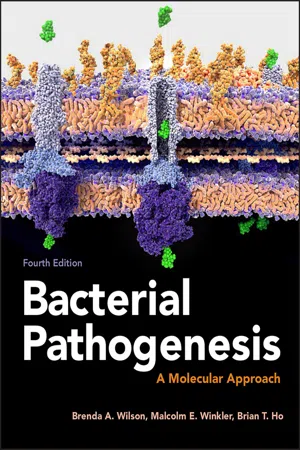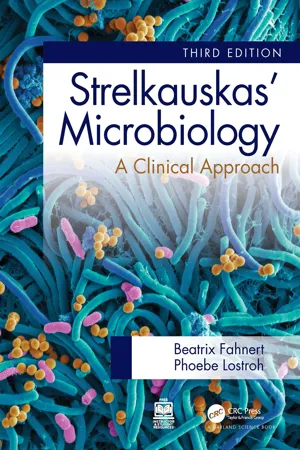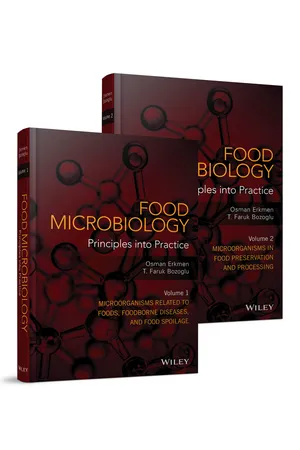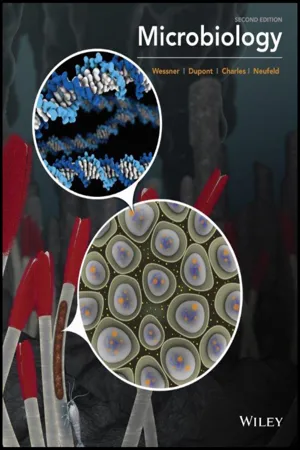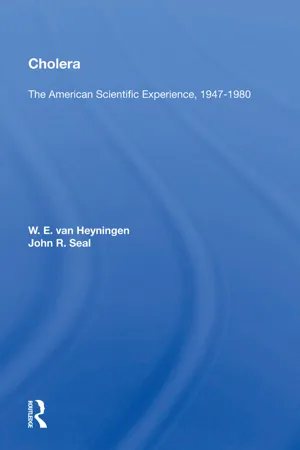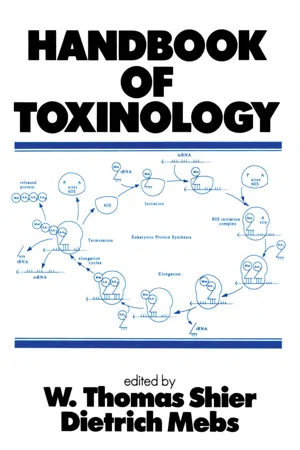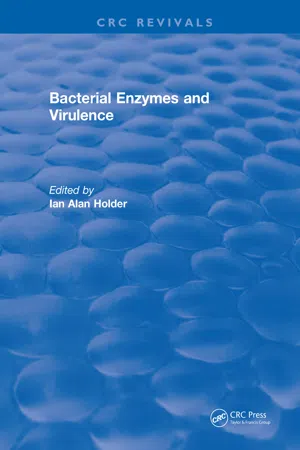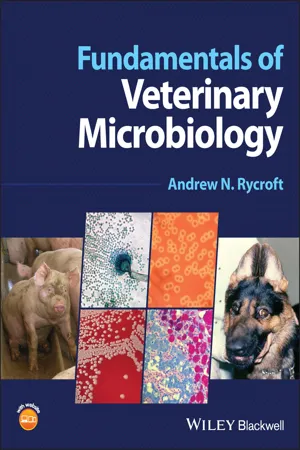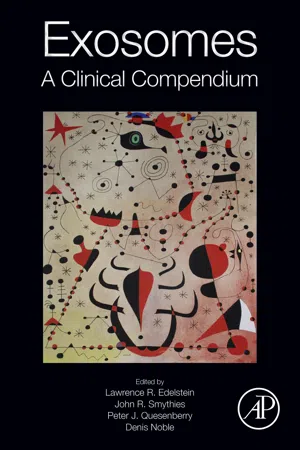Biological Sciences
Exotoxins
Exotoxins are toxic proteins released by certain bacteria into their environment. They can cause damage to host cells and tissues, leading to various symptoms of bacterial infections. Exotoxins are often responsible for the severe effects of diseases caused by bacteria, such as diphtheria, tetanus, and botulism.
Written by Perlego with AI-assistance
Related key terms
10 Key excerpts on "Exotoxins"
- eBook - ePub
Bacterial Pathogenesis
A Molecular Approach
- Brenda A. Wilson, Malcolm Winkler, Brian T. Ho(Authors)
- 2019(Publication Date)
- ASM Press(Publisher)
A term that has sometimes been used to designate the protein toxins of bacteria is exotoxin. The word “exotoxin” was chosen to emphasize the fact that the toxins are secreted from the cell into the medium, in contrast to endotoxins, which are components of the bacterial surface and mainly get released through bacterial cell lysis. The term “exotoxin” has been falling out of use because some protein toxins are not secreted but rather accumulate inside the bacterial cell and are released by cell lysis. Others are injected directly into human or animal cells, thereby bypassing the extracellular environment entirely. These toxins are often referred to as effector proteins or exoenzymes and are directly delivered into the host cell via specialized secretion systems. We will cover secretion systems and delivery of virulence factors in more detail later in chapter 13. For convenience, we will use the word “toxin” to mean all types of virulence factors of bacteria, whether secreted or not, that are toxic to the human or animal host. Bacterial toxins vary considerably not only in their structures and activities, but also in the host cell types they attack. Names given to different toxins reflect this diversity. Some toxins are simply given letter designations (e.g., exotoxin A of Pseudomonas aeruginosa), while other toxins are named for the numerical, Greek, Roman, or alphabetical order in which they were isolated or discovered from a bacterial species, such as the alpha-, beta-, gamma-, delta-, and epsilon-toxins produced by Clostridium perfringens. Some toxins are named to indicate what type of host cells they attack - eBook - ePub
Strelkauskas' Microbiology
A Clinical Approach
- Beatrix Fahnert, Phoebe Lostroh(Authors)
- 2023(Publication Date)
- Garland Science(Publisher)
Figure 5.16). Exotoxins are among the most lethal substances known: some Exotoxins are a million times more potent than the poison strychnine, which frequently features in detective fiction. Many of the genes that encode these toxins are carried on prophages or plasmids in the pathogens, which adds to the danger because these are mobile genetic elements that can transfer this genetic information from one bacterium to another.There are several types of exotoxin. They are often grouped via their structure or mode of action. Examples are cytotoxins, which kill cells that they come in contact with; neurotoxins, which interfere with neurological signal transmission; and enterotoxins, which affect the lining of the digestive system (). We will now explore some of the more dangerous Exotoxins.Table 5.3Anthrax Toxin
Anthrax toxin is a cytotoxin produced by the bacterium Bacillus anthracis, a Gram-positive rod commonly found in the soil of pastures. The toxin is made up of three parts: an edema factor (EF), a protective antigen (PA; a transmembrane factor also used for vaccine production), and a lethal factor (LF). Each bacterium produces the parts separately and assembles them on its surface in such a way that the complex is not yet toxic. The complex then leaves the surface and attaches to a host cell. Once attached to its target cell, the complex is endocytosed into a vesicle, where the low pH causes a conformational change in the complex, converting it to the toxic form. In this state, the protective antigen forms a pore in the vesicle membrane, and the edema and lethal factors temporarily change their shape so that they can squeeze into the host cell’s cytoplasm.Anthrax toxin interrupts the signaling capability of host macrophages and causes their death. It also interrupts the signaling capability of dendritic cells but does not kill them. However, even though they are still alive, the infected dendritic cells are no longer able to participate in the host defense against the infection. The importance of the loss of macrophage and dendritic cell function will become obvious in Chapters 15 and 16 - eBook - ePub
Food Microbiology
Principles into Practice
- Osman Erkmen, T. Faruk Bozoglu(Authors)
- 2016(Publication Date)
- Wiley(Publisher)
Exotoxin is the term used to describe toxins that are released extracellularly by living bacteria during exponential growth. In some cases, Exotoxins can also be released by lysis of the bacterial cell or may be removed from the side of bacterial growth. Exotoxins are usually proteins, minimally polypeptides that act enzymatically or through direct action with host cells and stimulate a variety of host responses. Bacterial Exotoxins act at the site of pathogen colonization and growth, and some bacterial toxins promote bacterial invasion. Exotoxins have toxicity and antigenicity. These include enterotoxins that act on the intestinal mucosa and generally cause diarrhea, cytotoxins that kill host cells, and neurotoxins that interfere with normal nervous transmission. Several bacterial Exotoxins can act directly in the immune system and can cause impairment to the immunologic functions. These toxins are called pyrogenic Exotoxins produced by staphylococci (enterotoxins) and streptococci (pyrogenic Exotoxins).Exotoxins of bacteria have different pathogenic ability. C. tetani exotoxin blocks action of neurons of spinal cord and causes tetanus. C. perfringens exotoxin (enterotoxin) causes gas gangrene. Exotoxin (alpha toxin) has lecithinase activity and thereby causes cell death. Its enterotoxin causes secretion of water and electrolytes in diarrhea. Clostridium botulinum exotoxin (neurotoxin) causes paralysis respiratory muscles, and blocks release of acetylcholine of synapses and neuromuscular junctions. V. cholerae (strains 01 and 0139) exotoxin (enterotoxin) causes secretion of water and electrolytes within the gut in diarrhea. Enterotoxigenic E. coli exotoxin (heat labile exotoxin) causes secretion of water and electrolytes within the gut. S. dysenteriae exotoxin causes acute inflammation. S. aureus exotoxin (enterotoxin) causes toxic shock syndrome, stimulates vomiting center of brain, and associates with watery diarrhea. S. pyogenes exotoxin (erythrogenic toxin) causes scarlet fever and toxic shock syndrome. Some other pathogenic bacteria producing Exotoxins (enterotoxins) are Vibrio parahaemolyticus, Yersinia enterocolitica, and Aeromonas hydrophilia - eBook - ePub
Biology for the Health Sciences
Mechanisms of Disease
- Mark F Wiser(Author)
- 2023(Publication Date)
- Garland Science(Publisher)
FIGURE 19.5 ) and binding to the host receptor facilitates the entry of some Exotoxins into the host cell. Quite often these Exotoxins have an enzymatic activity that modifies specific targets within the host cell and modification of the target affects cellular physiology. Toxins with enzymatic activity are quite potent and exhibit toxic effects at low concentrations.FIGURE 19.5Action of bacterial Exotoxins. Exotoxins are secreted by bacteria and bind to host receptors. For some Exotoxins, binding to the receptor facilitates entry of the toxin into the cell.AB toxins are a class of Exotoxins that alter specific aspects of cellular physiology
AB toxins are composed of two subunits: the A subunit has some ‘activity’ that is responsible for the toxicity and the B (binding) subunit that binds to receptors on the host cell and facilitates the entry of the A subunit into the cell. The A subunit typically has an enzymatic activity that modifies a host cell component. For example, several bacterial toxins add an ADP-ribose group to the cellular target protein, and this causes cellular dysfunction or toxicity (FIGURE 19.6 ). One class of AB toxins is called AB5 because the B subunit is a pentamer of five polypeptides. The host cell receptor for AB5 toxins is the carbohydrate portions of specific glycoproteins and glycolipids. Four different classes of AB5 toxins have been described based on the receptor recognized by the B subunit, and the activity and target of the A subunit (TABLE 19.6 ). Like many other virulence factors, AB toxins are often associated with mobile DNA elements that can be transferred within a species or between species via horizontal gene transfer (see Box 19.4 ).FIGURE 19.6Mechanism of action of bacterial toxins. - eBook - ePub
- Dave Wessner, Christine Dupont, Trevor Charles, Josh Neufeld(Authors)
- 2016(Publication Date)
- Wiley(Publisher)
M. tuberculosis.21.1 Fact Check
- What are the main virulence factors used by bacterial pathogens?
- Describe examples of attachment virulence factors.
- In what ways do capsules protect pathogens?
- How do secretion systems of Gram-negative bacteria contribute pathogenesis?
- Describe how bacterial pathogens obtain iron.
21.2 Bacterial virulence factors—toxinsHow do bacterial toxins act on host cells?Continuing from what we have learned in the previous section, toxins are common virulence factors used by bacteria to gain nutrients from the host. A toxin is a poisonous substance that is produced by an organism. Bacterial toxins have diverse origins, structures, and activities, but they can be classified into a few general types based on mode of action or structure. These include endotoxins, A-B toxins, cytolysins, and superantigens. We will look at examples of each in this section but, before we do this, some toxin terminology will be clarified.are soluble proteins originating in the bacterial cytoplasm that are actively secreted to the external environment or are passively released upon bacterial lysis. Exotoxins have diverse origins, structures, and activities. They are commonly grouped by their structure, such as A-B toxins, for their molecular activity, such as superantigens, or for their cellular activity, such as cytotoxins.ExotoxinsIf the toxin is part of the cell wall structure, it is called an. Historically, the term “endotoxin” is reserved only for Gram-negative bacteria because it specifically refers to lipopolysaccharide (LPS). Lipoteichoic acid (LTA) is a Gram-positive cell wall-associated toxin, yet it is not referred to as endotoxin, although it has biological activity similar to LPS. Both these cell wall components can trigger an inflammatory response in the body that is responsible for many of the symptoms of disease. These toxins will be investigated in the next section. Toxins that act directly on host cells are called cytotoxinsendotoxin - 2 not only for want of supporting evidence but also because of the discovery of three powerful bacterial toxins—those of diphtheria, tetanus and botulism—that were definitely not small-molecular ptomaines, but large, "ferment-like" protein molecules. Up to this stage, there had been no real evidence of any poison being produced by any pathogenic microbe under the conditions of a natural disease, and the idea of a bacterial poison had had no real basis—it was simply a notion that easily sprang to mind and filled the vacuum that existed for want of any other explanation for the harmful effects of infectious diseases. And except for the few diseases to be discussed, this vacuum persists today.Since the discovery of diphtheria, tetanus and botulinum toxins, it has been shown that many other pathogenic bacteria produce toxins, but the fact that a pathogenic organism produces a particular toxin does not necessarily mean that the toxin plays an important part in producing the harmful effects of the infectious disease. In cases other than diphtheria, tetanus, botulism and cholera (and some other diarrhoeal diseases), there is no good reason for concluding that any toxin produced does, or does not, cause harm in the course of the disease.32. Exotoxins and EndotoxinsThere are two types of bacterial toxins, Exotoxins and endotoxins, so named originally because it was believed that, respectively, they were secreted by Gram-positive organisms into the culture medium, or contained within the cell substance of Gram-negative organisms. This distinction is no longer so clear, but there are more important differences, shown in Table 2.1
- eBook - ePub
- W. T. Shier, W. T. Shier(Authors)
- 2020(Publication Date)
- CRC Press(Publisher)
9 Bacterial Endotoxins JAROSLAV HOFMAN Institute of Microbiology, Czechoslovakian Academy of Science, Prague, Czechoslovakia- INTRODUCTION
- LOCALIZATION AND STRUCTURE
- Localization of endotoxins in the cell membrane
- Isolation
- Chemical structure and assay
- Chemical structure of endotoxins
- Synthetic lipid A
- Depyrogenation or detoxification of endotoxin
- Assay of endotoxins: Limulus amebocyte lysate (LAL) test
- BIOLOGICAL ACTIVITIES
- Lethality
- Endotoxin-complement system interaction
- Interaction with the blood coagulation system
- Antibody response to endotoxin
- Stimulating and suppressive effect on the immune response
- Endotoxin effects on nonspecific resistance to infection
- Endotoxin and tumors
- Endotoxin-induced release of mediators
- CONCLUSION
- REFERENCES
I. Introduction
Endotoxin is a historical term for high-molecular substances from gram-negative bacteria. The name indicates that endotoxin is a constitutive part of a bacterial cell (“endo”) which, when applied to an organism, induces pathological changes (“toxin”). The term arose from observations that endotoxin is released from cells only with difficulty, either after breakdown or digestion of the cell. Together with relative thermostability, these properties distinguish endotoxin from thermolabile Exotoxins, which, on the other hand, are spontaneously released by the microorganisms into the growth medium or during infection. Although the term “endotoxin,” which originated at the beginning of this century, has been replaced by other names expressing its partial properties, it is still used, and it denotes the most complex definition of the substance. An endotoxin is not only toxic, but it exhibits various other biological activities when administered to higher organisms or when added to humoral or cellular components in vitro. The spectrum of activities is unusually broad and unique among toxins. On the other hand, it is a substance present in very small but definite amounts in our body during our whole lifespan. It is not known what biological functions are affected by these low concentrations. - eBook - ePub
- Ian Alan Holder(Author)
- 2018(Publication Date)
- CRC Press(Publisher)
Invasiveness of bacterial pathogens is enhanced in strains that can release amino acids, amino sugars, and/or iron from host macromolecules for nutritional use by the invader. Moreover, toxigenesis consistently requires a narrower “window” of range of concentration of specific nutrients and of environmental conditions than does growth of the producer bacteria. Accordingly, despite bacterial growth, toxin formation might not be able to occur in some tissues and fluids. The host would therefore have more time in which to mobilize defense cells to eradicate the infection.In a few instances, a nutrient that cannot be synthesized but which must be obtained from the host is required as a component of a bacterial toxic protein. Conceivably, the function of some features of virulence might well be that of adjusting the levels of available nutrients so that the pathogen can not only multiply but, upon cessation of growth, could differentiate into the phase of formation of toxic secondary products.References
1 . Koser, S. A., Vitamin Requirements of Bacteria and Yeasts, Charles C. Thomas, Springfield, 111., 1968, chap. 19.2 . Schneider, D. R. and Parker, C. D., Isolation of characterization of protease-deficient mutants of Vibrio cholerae, J. Infect. Dis., 138, 143, 1978.3 . Barbour, A. G., Vaginal isolates of Staphylococcus aureus associated with toxic shock syndrome, Infect. Immun., 33, 442, 1981.4 . Cicmanec, J. F. and Holder, I. A., Growth of Pseudomonas aeruginosa in normal and burned skin extract: role of extracellular proteases, Infecí. Immun., 25, 477, 1979.5 . Snell, K., Holder, I. A., Leppla, S. A., and Saelinger, C. B., Role of exotoxin and proteases as possible virulence factors in experimental infections with Pseudomonas aeruginosa. Infect. Immun., 19, 839, 1978.6 . Holder, I. A. and Haidaris, C. G., Experimental studies of the pathogenesis of infections due to Pseudomonas aeruginosa: extracellular proteases and elastase as in vivo virulence factors, Can. J. Microbiol., 25, 593, 1979.7 . Pavlovskis, O. R. and Wretlind, B., Assessment of protease (elastase) as a Pseudomonas aeruginosa virulence factor in experimental mouse burn infection. Infect. Immun., - eBook - ePub
- Andrew N. Rycroft(Author)
- 2023(Publication Date)
- Wiley-Blackwell(Publisher)
2018 ).There are six categories of bacterial Exotoxins. These are usually released during bacterial growth.- Cytolytic toxins
- Enzymes
- Enterotoxins/ADP‐ribosylation toxins
- Neurotoxins
- Superantigens
- Type III secretion systems
Cytolytic Toxins
The cytolytic toxins are sometimes, but not always, haemolysins. Haemolysins are often recognised and discussed as a property of bacteria because they are easily seen around colonies on blood agar; they are easy to study. Haemolysin production is used to describe and identify bacterial colonies. Haemolysins are also sometimes associated with pathogenic species. However, they are also produced by entirely non‐pathogenic bacteria such as Bacillus species readily isolated from the normal air. Conversely, other bacteria produce cytolysins that contribute to pathogenicity, yet these have no haemolytic effect.The effect of streptolysin S around colonies of Streptococcus equi.Figure 5.7An example of a haemolytic and cytolytic toxin is streptolysin S. This toxin is, like many, most extensively studied in the exclusively human pathogen Streptococcus pyogenes (or Lancefield Group A streptococcus), but very closely related cytolysins are found in β‐haemolytic strains of S. equi, S. equisimilis and Group G streptococci and indeed a number of other bacterial pathogens (Figure 5.7 ).Streptolysin S is a small, yet potent cytolytic toxin. It is a 2.7 kDa peptide that can only be cytotoxic when associated with the bacterial cell surface or when specific carrier molecules are present. It has a broad spectrum of cytolytic activity against mammalian cells, including erythrocytes, platelets and leucocytes. The mechanism of cell damage is not yet understood but is thought to form pores through the cell membrane and disruption of the cell contents. - eBook - ePub
Exosomes
A Clinical Compendium
- Lawrence R. Edelstein, John R. Smythies, Peter J. Quesenberry, Denis Noble(Authors)
- 2019(Publication Date)
- Academic Press(Publisher)
Exosomes and other EVs have been isolated and characterized in the context of all known pathogen classes including viruses, parasites, fungi and bacteria. However, the composition and activity of these EVs vary significantly between the different taxa and even between pathogens in the same genus. Moreover, various factors such as the animal model used, the experimental design, the cell types chosen for the infection and which recipient cells are targeted, will affect the results observed.During a bacterial infection, the host immune system is exposed to intact bacteria and to microbial components, and both are key to controlling the infection as well as the subversion of the immune system by the pathogen. Many of the bacterial components known to be involved in the activation/subversion of the immune response are secreted or released from the bacteria during an infection. Defining these bacterial factors as well as how they disseminate during an infection are necessary for our understanding of the disease and how our immune system responds to the infection. EVs are a newly described mechanism for dissemination of these bacterial components (Table 1 ). Much of our knowledge regarding exosome/EV production and function following a bacterial infection stems from work on mycobacteria, which will be discussed first, followed by an analysis of exosomes/EVs in the context of other bacteria.Table 1 Exosome production by host cells post bacterial infectionBacterial pathogen Host sources References Chlamydia trachomatis Fibroblast [41] Chlamydia pneumoniae ECV304 cells [42] Mycobacterium tuberculosis Macrophages, plasma [14 , 43 –49 ] Mycobacterium bovis BCG Macrophages, plasma, BALF [48 , 50] Mycobacterium smegmatis Macrophages [51] Mycobacterium avium Macrophages [51 –53 ] Salmonella typhimurium Macrophages [14 , 54] Mycoplasma spp. Tumor cells [55] Bacillus anthracis Retinal pigment epithelial cells [56] Pseudomonas pneumoniae Type-I alveolar epithelial cells, BALF
Index pages curate the most relevant extracts from our library of academic textbooks. They’ve been created using an in-house natural language model (NLM), each adding context and meaning to key research topics.
